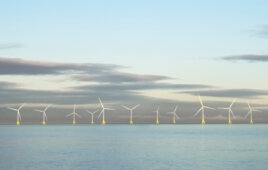 The Fraunhofer Institute for Wind Energy and Energy System Technology (Fraunhofer IWES) has verified the accuracy of Galion Lidar’s “remote mast” function. This is the first independent validation of this novel wind measurement method in the industry.
The Fraunhofer Institute for Wind Energy and Energy System Technology (Fraunhofer IWES) has verified the accuracy of Galion Lidar’s “remote mast” function. This is the first independent validation of this novel wind measurement method in the industry.
The research institute says that Galion Lidar, a remote wind measurement device developed by international renewable energy consultancy, SgurrEnergy, “may be recommended […] for a power performance assessment offshore with the lidar installed on the transition piece of the test turbine.”
Power performance assessment of offshore wind turbines is essential to ensure they are working correctly, however the use of conventional met mast technology to carry out these tests comes at a high cost. The innovation of low cost, lidar-based alternatives to measure wind speed has been stimulated by the need to reduce these costs.
These include lidars installed on fixed or floating platforms, on the nacelle of the test turbine, or acquiring remote mast measurements from the transition piece (the walkway at the bottom of the tower). Floating and nacelle mounted solutions are explicitly excluded by current IEC standards, which state, “Only ground based remote sensing devices are used (e.g. nacelle mountings are not included).” Only Lidars situated on the transition piece of the test turbine or on fixed platforms comply with this IEC requirement.
According to the Fraunhofer IWES study, Galion Lidar’s “remote mast” capability allows measurements “where a horizontal distance between the location of the measurement device and its measurements is necessary”. This lets IEC compliant measurements be obtained at a fraction of the costs of the current standard method by a Galion installed on the transition piece of an offshore wind turbine. The measurements were compared to an IEC compliant met mast, and “the results of the verification test indicate a good agreement.” The comparison was undertaken in moderately complex terrain and so “it is expected that the uncertainties [for offshore power curve tests] are even smaller […] since the influences of the terrain would be less significant for an offshore site.” The distance and height over which the test was conducted met the requirements of an IEC compliant power curve test.
The Galion’s capabilities offshore have recently been demonstrated by a series of high profile deployments in the North Sea, Baltic Sea, and South China Sea. Galion Lidar is currently performing an offshore power performance assessment on the transition piece of a wind turbine in the Alpha Ventus offshore wind farm as part of a joint measurement campaign with AREVA Wind.
The approval of the lidar capabilities by Fraunhofer IWES follows a series of independent verifications of the device. Galion was given the seal of approval by wind energy experts, Deutsche WindGuard in March, was independently certified by Risø DTU in Denmark and is routinely tested at SgurrEnergy’s remote sensing test facility at Carrot Moor in Scotland.
SgurrEnergy
www.sgurrenergy.com
Filed Under: News




